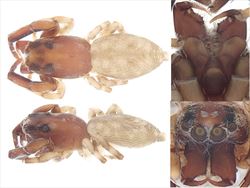Ancipitilobus Richardson, 2016
Taxonomy
Ancepitilobus has one species, Ancepitilobus howensis, from Lord Howe Island.
Description
Ancepitilobus sp. is a small, flattish spider ranging in body length from 4 to 5 mm. When viewed from above, the cephalothorax and the abdomen are roughly elliptical, the cephalothorax widening slightly towards the rear. From the side the cephalothorax is high and horizontal until well behind the posterior lateral eyes. The abdomen and second to fourth pairs of legs are light in colour while the cephalothorax and the first pair of legs are dark brown. Chelicerae in both sexes have a straight outer edge, a single subdivided (fissident) retromarginal tooth and two teeth on the promargin. The first pair of legs is stronger than the others.
The male’s palp has a slim embolus, hooked at the end, arising on the lateral, distal third of the tegulum. A longer independent guide projects distally from the edge of the tegulum, somewhat larger and stronger than the embolus, curving anti-clockwise back towards it. The tegulum is oval-shaped, without a proximal lobe. The retro-lateral tibial apophysis has a single, medium-sized, broad apophysis, pointed at the tip.
The female has a thick, sclerotised shield covering the posterior (proximal) half of the epigyne, with the copulatory openings in the lateral edges of the shield. The rounded spermathecae are anterior to the shield.
Biology
Nothing is known of the biology of Ancepitilobus.
Distribution
Ancepitilobus is known only from Lord Howe Island.
References
Richardson, B.J. 2016. New genera, new species and redescriptions of Australian jumping spiders (Araneae: Salticidae). Zootaxa 4114, 501-560.
Richardson, B.J. & Żabka, M. 2017. Salticidae. Arachnida: Araneomorphae. Canberra, Australian Faunal Directory. Australian Biological Resources Study, at https://biodiversity.org.au/afd/taxa/SALTICIDAE.
* The information sheet should be interpreted in the context of the associated diagrams and photographs. Diagrams explaining anatomical terms can be found in the ‘Salticidae’ pictures at the beginning of the list of genera.

